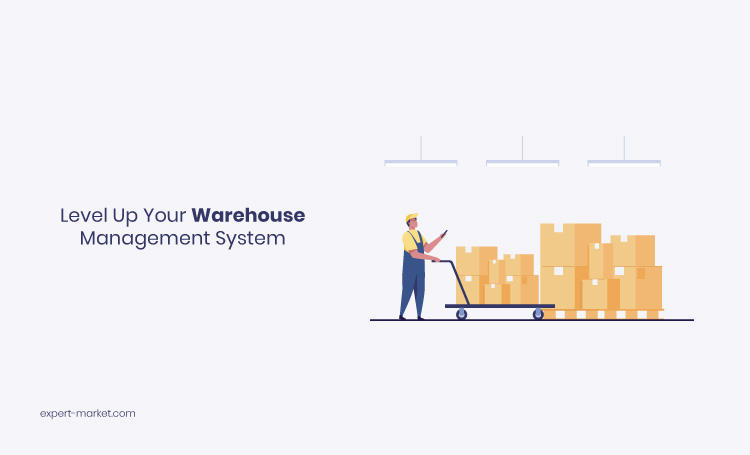The quality of your warehouse management system can make or break the success of your business. Efficient warehouse management systems can keep customers happy and costs low. When your warehouse management system is ineffective, inventory isn’t shipped and received on time, workers are unproductive, and the company eventually loses credibility and money.
Even though its operation is behind the curtains, your warehouse management system has been and will always be the heart of your company. The more efficient your warehouse operations are, the easier it’ll be for your business to attain long-term success in the industry.
Here are five ways to level up your warehouse management system:

1. Embrace Technology
Technology has drastically improved warehouse operations. Today, you can find different apps and software that can expedite warehouse processes without spending more resources. Technology also improves the productivity of your employees as they can do more within a shorter period of time.
One of the most common technologies you can use to improve your warehouse management system is barcode scanning. This technology saves your team time and effort from manually checking incoming and outgoing goods and enables them to log receipts, track movements in the warehouse, and dispatch goods.
There are plenty of technologies available to improve the efficiency of your warehouse management system. Carefully pick which among these best suit your business’s needs and budget.
2. Incorporate Lean Warehouse Practices
Gone were the days when warehouses were only used to store goods. Because of the advent of technology and the demand in the globalized markets, warehouses have become more important than ever.
Adapt to the ever-competitive world of business by incorporating lean practices into your warehouse management system. Lean warehouse practices are the process of developing warehouse operations to minimize the consumption of resources without compromising quality or productivity. In short, lean warehouse practices ensure that your team doesn’t use more resources than they actually need to complete tasks.
To incorporate lean warehouse practices, you need to adapt to its 5S methodology:
- Sort: Define which existing processes are necessary and unnecessary. The goal here is to identify which areas of your warehousing operations are preventing your team from reaching their full potential. This is the first step to determine which processes should be retained, improved, or eliminated.
- Streamline: Eliminate superfluous processes without sacrificing the productivity of your team. You can achieve that goal by assigning team members in the best positions so they can easily accomplish tasks and improving warehouse accessibility using intuitive layouts.
- Shine: Ensure that your warehouse is clean 24/7. This means that cleaning materials should be available and accessible, trash receptacles should be visible throughout the warehouse, and cleanup processes should be included in your warehouse workflow.
- Standardize: At this phase, you’re expected to develop better protocols and procedures for your warehouse team to follow. To ensure that your team follows protocols, prioritize providing structured training, developing customized workflow documentation, and displaying visible signs in the warehouse to display instructions.
- Sustain: Exert resources to ensure that existing protocols are implemented properly and continuously seek improvement—this phase is a balancing act. Sustaining your approach involves conducting assessments with teams and asking for feedback regularly.
3. Never Procrastinate When Receiving Shipments
Processes in your warehouse are interconnected. A delay in one process can mean significant damage in other aspects and can eventually hurt your overall warehouse operations.
Another way to level up your warehouse management system is to avoid delays when receiving shipments. Aside from adversely affecting the efficiency of your warehouse operations, delays can also take a toll on your team’s safety as orders left on pallets can become a trip and fall hazard.
Make an effort to process orders the moment they arrive in your warehouse. This improves and expedites your overall warehouse operations and allows your team to accomplish more orders every day.
4. Conduct Employee Training
Your efforts to improve your warehouse management system won’t provide the best results if employees aren’t fully aware of what they’re doing. How can your team become more efficient if they don’t know how to utilize the tools in the warehouse? How can they adapt to industry trends if they continue to implement old processes?
Conducting regular employee training is a must to improve your warehouse management system. This training should cover everything from educating employees on the types of goods they’re handling, health and safety protocols they should follow, and the proper way to use different equipment.
Investing in employee training will require resources from your business, but the rewards will be worth it. Trained employees are more productive and enable your warehouse to process more orders efficiently.
5. Improve Warehouse Organization Or Layout
Effective warehouse management systems go hand-in-hand with the layout of your warehouse. Your warehouse management system will never improve unless you pay attention to the organization or layout of your warehouse.
There are many strategies to improve warehouse organization or layout, namely:
- Maximize vertical space: Leasing or buying a warehouse is expensive, which is why it’s crucial to maximize every square inch of the space. Instead of moving to another warehouse as your business grows, aim to utilize vertical space by installing a mezzanine area. This might surely entail costs, but taking this route is cheaper than moving to another facility.
- Remove clutter: Remove any types of clutter from your warehouse as this can negatively impact the health and safety of your teams, as well as their picking efficiency. Remove obstacles in your warehouse so pickers can easily travel around different areas.
- Plan for peaks: Before taking on a large amount of inventory, plan where you’re going to store the additional goods. Instead of bringing more profits to the business, an influx in inventory can result to inefficient processes if you have nowhere to put it.
Don’t Stop Optimizing
Levelling up your warehouse management system isn’t a one-time feat. It’s important to consistently review your strategies to analyze the performance of your warehouse and how it compares to the trends in the industry and strategies implemented by your competitors.
Invest in regular training and technology developments to keep your warehouse operations ahead of the curve. Ask feedback from clients and employees whenever necessary to know how your warehouse operations can improve in the long run.



























